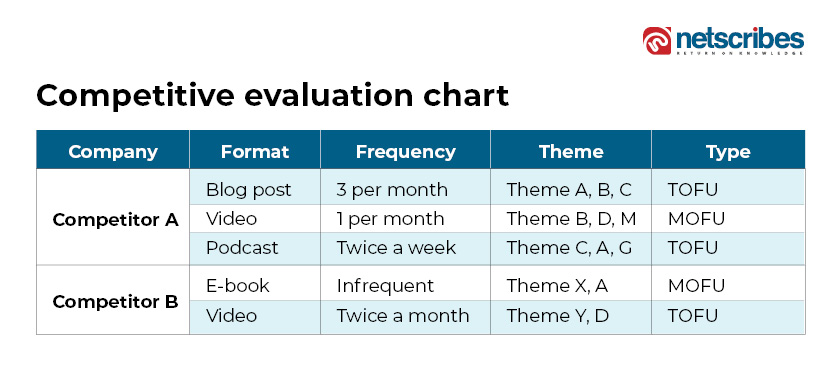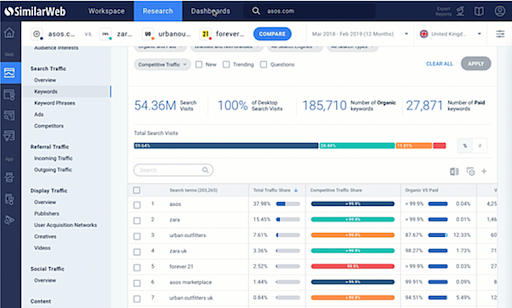You have an excellent content marketing strategy. But so does your competitor. However, by tomorrow, yesterday’s approach might well be obsolete. Ensuring that your content marketing hits the mark in today’s digitally driven market is a persistent challenge. In fact, 27% of marketers across various industries report that generating traffic and leads is the biggest challenge. Privacy concerns, technical and regulatory changes in the digital landscape, and an influx of industry-wide content have rendered efforts to drive organic website traffic (and thereby generate leads) more difficult. In such a scenario, marketers need data-driven insights to ensure that their content marketing efforts deliver results. Here’s how content competitive analysis can meet this need and better your content marketing efforts.
Related reading: A guide to B2B content marketing in 2023
1. Evaluate key themes and frequency of posting
Find out how often competitors publish content on their website, social media handles, and third-party platforms. Capture what they write about, including the topics/themes, the services/products they promote, and the formats they use.

You will likely find that your competitors focus on achieving specific goals, for example, establishing themselves as experts in a specific service or product market. This content competitive analysis exercise will help you identify ways to differentiate your content, identify new content themes, and optimize your own content publishing strategy.
2. Identify keyword gaps
Identifying the right search keywords for your business is the key to building search-optimized content. Search keywords can provide insight into your customers’ informational needs and makes a integral part of the content competitive analysis strategy. By doing so you can create content that’s relevant to you customers. But let’s be honest. Keyword research isn’t straightforward. It takes a lot of research to identify keywords that drive relevant traffic and conversion on your website.
Here’s where a keyword gap analysis can help.
A keyword gap analysis tells you which keywords are missing from your website compared to your competition. By identifying which keywords bring the most traffic to your competitors, you can identify missed opportunities and plan your content strategy accordingly.
Here’s how to conduct a keyword gap analysis:
- Audit your website to see which keywords it ranks for, in addition to the search position for each keyword. You can do this by extracting a performance report on the website’s Google Search Console.

- Analyze your competitor’s website to find out which keywords they rank for and their respective search positions. You can use generally tools like Ahrefs’ Site Explorer to gather this data.
- Compare both, the keywords and search positions, to identify opportunities to add new keywords to your content and outrank your competition. To increase traffic, you should aim to rank in the top 10 search results for relevant keywords.
- Find out how they promote their content.
Creating content is only half the battle. Promoting it is just as important, if not more than creating content. Here’s where leveraging content competitive analysis for your content marketing strategy comes in. A comprehensive competitive analysis helps you reach as many people as possible, even more so who are relevant to your industry. By gathering intel about your competitors’ content promotion tactics, you’ll be able to find ways to optimize your own content promotion strategies.
This includes monitoring the following:
- Medium: Find out which channels competitors use to disseminate their content, for example, email, social media, and third-party websites.
- Frequency: Promote Each piece of content multiple times across channels. It’s especially good to know how often each content asset is promoted.
- Content repurposing: See how your competition is utilizing existing content to generate interest. For example, you may observe an existing report being used for creating blog posts and articles for third-party websites, Pinterest infographics, social media posts, and so on.
3. Optimize ad performance
Paid digital ads are extremely competitive in nature. There are several advertisers competing for the same customers and ad space. To maximize the conversion value of your ads, they must be better in quality and have a higher bid value than the competition. Obtaining intel on your competitors’ ads can help you stay a step ahead.
Ad intelligence software and tools enable you to evaluate and understand the performance of your display, search, and pay-per-click ads. Not only this, they provide insights into your competitor’s ad spending like the channels and platforms they are advertising on, the types of ads they’re running, and the amount they are spending. SimilarWeb, for instance, is a tool that provides a competitive overview of ad placement and performance including traffic driven to the website. These tools ultimately form the differentiating layer for thorough content competitive analysis.

You can further use the insights obtained to inform your own strategies, improve your ad campaigns, and explore undiscovered opportunities.
The bottom line? content competitive analysis is key to a differentiated content marketing strategy. Incorporating CI will certainly help you stay on top of new developments, offer inspiration for better content, and ensure you don’t miss out on key themes in your industry.
A variety of factors can impact the quality of your marketing content. If you are looking for support, we are here to help!






